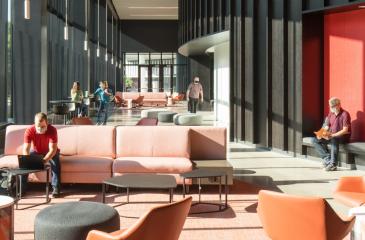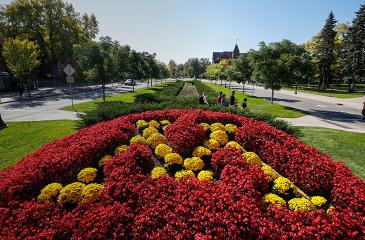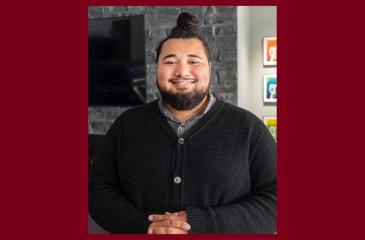“The new Health Sciences Education Center (HSEC) is much more than a building; it is a catalyst for change as we prepare the next generation of health care professionals,” said Mark Rosenberg, MD, vice dean for education and academic affairs in the Medical School. “HSEC provides the space and momentum to continue to develop evidence-based education that includes more active learning using interactive classrooms, simulation facilities, and library resources which are part of the building. The space will promote interactions between students from multiple professions and disciplines as they learn, study and socialize with each other. It is a state-of-the-art space that is both functional and beautiful. Students, faculty and staff are excited and energized by the opportunities HSEC will bring to all of us.”
Today’s new models of health care require different professions to work together using new strategies and technologies. HSEC signals a transformation in health sciences education and brings together all of the health sciences schools and affiliated programs at the University of Minnesota. With an emphasis on interprofessional collaboration and training based on real-life scenarios, HSEC prepares future health professionals for the demands of our time.
“The opening of HSEC will provide the space for students, faculty and staff to create new ways of learning how to provide good healthcare to people,” said Jeannine Conway, PharmD, BCPS, associate dean of professional education in the College of Pharmacy. “As faculty we look forward to students from across academic health sciences being able to come together to begin to form interprofessional relationships while in the early stages of their education.”
© Lara Swimmer
At 202,000 gross square feet, HSEC is one of the most comprehensive interprofessional education facilities in the country. HSEC offers innovative classrooms with active learning and small-group teaching spaces and are equipped with video conferencing to enable distance learning. A virtual tour of the cabaret two-level classroom can be viewed here.
“The faculty in the School of Nursing are highly enthused about teaching in active learning classrooms and have been restructuring courses to leverage the use of active learning classrooms,” said Christine Mueller, PhD, RN, FGSA, FAAN, professor and senior executive associate dean for academic programs in the School of Nursing. “Further, HSEC will facilitate natural opportunities for health sciences students to learn together formally and informally.”
© Lara Swimmer
HSEC is the new home for the Center for Health Interprofessional Programs (CHIP), which offers health professions students unique and innovative opportunities to connect, collaborate, and network. Throughout the building, quiet study, group study, wellness rooms, including a yoga studio, and lactation rooms are available. HSEC’s spaces promote a culture that values student and faculty well-being.
“The building of HSEC is an important and quite literal bright spot in the education and experience of health sciences students. I am excited for current and incoming students to have interactive spaces that promote a sense of openness to each other and the environment,” said Sruthi Shankar, MD candidate, class of 2022.
“One of the barriers to intersectionality in health education that we currently face in our existing buildings is that students don't often have welcome access to each other outside of CHIP. I am hopeful that by having large student lounges and new classrooms, the various health sciences programs will be better able to collaborate on creating meaningful interprofessional experiences for their students," said Shankar.
Students, staff, and faculty have access to resources including the Health Sciences Library and the Wangensteen Historical Library of Biology and Medicine, who have experienced staff with expertise in emerging technologies. Features include virtual and augmented reality, data visualization, 1:Button video recording studios, a makerspace with tools to support problem-based learning, and a faculty commons to facilitate technology integration into the learning environment.
“The facility has created an amazing interdisciplinary educational opportunity for all who are engaged in health sciences learning,” said Brenda Trebesch, senior facilities planner. “It will advance the movement toward team-based healthcare and meet the new, more stringent national accreditation requirements. It has been an exciting journey and certainly puts the University of Minnesota at the forefront of health sciences education.”
© Lara Swimmer
M Simulation, located on the 5th and 6th floors of HSEC, offer enhanced simulation and immersive training environments that allow students to learn in sophisticated, real-world settings, including both acute and ambulatory care spaces. Other spaces include trainer stations, briefing/debriefing rooms, and actor prep areas. M Simulation works collaboratively with faculty to support students across the health professions to learn and solve problems together.
“When health professional students come together there is strength in the collective effort to bring change to some of the most important aspects of health care - but even more so, it proves that we were designed to live in community with others,” said Ally Taubenheim, DNP student, School of Nursing. “This is interprofessional education.”



